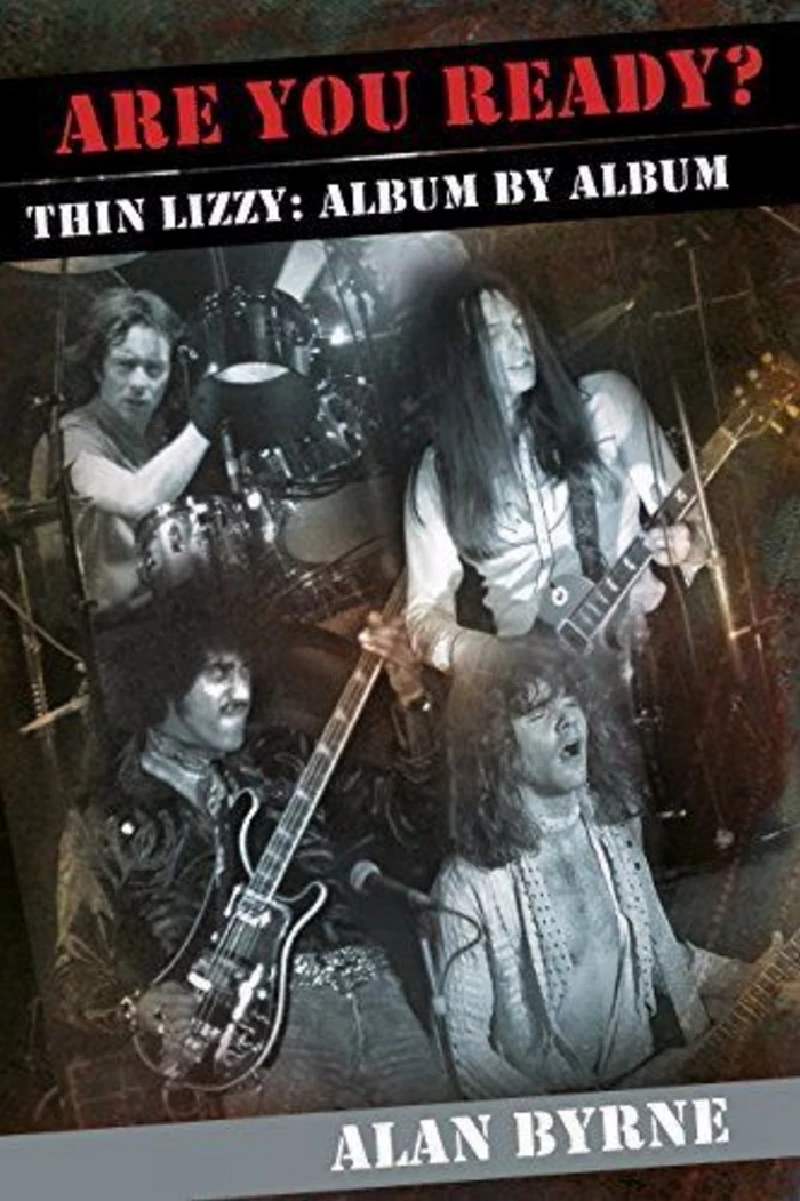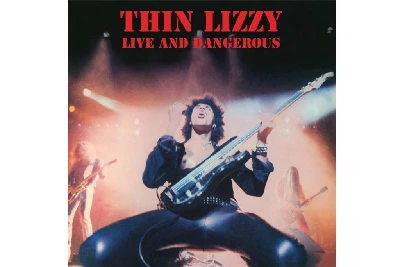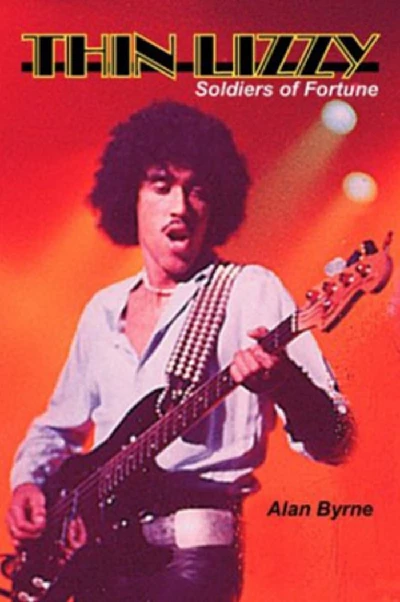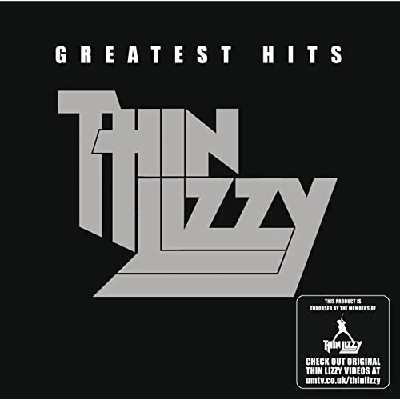Thin Lizzy - Raging Pages
by Lisa Torem
published: 5 / 2 / 2016

intro
Lisa Torem enjoys reading Alan Byrne’s insights in Are You Ready? Thin Lizzy: Album By Album and elaborates on why, in this month’s 'Raging Pages' column
In 'Are You Ready? Thin Lizzy: Album By Album', (Soundcheck Books), author Alan Byrne has published interviews/quotes from more than sixty, significant individuals that contributed to Thin Lizzy’s legacy. At the onset, the reader travels back to a simpler time when club owners of show bands sent young musicians off with misgivings, blessings and the occasional amplifier. This is not Byrne’s first time chronicling the band. In 2005 he wrote ‘Thin Lizzy’ (SAF) and in 2012 ‘Philip Lynott: Renegade of Thin Lizzy’ (Mentor). Byrne writes with the unpretentious confidence of a seasoned author. His well researched data and casual tone make this book an enjoyable and educational read. The main event begins when instrumentalist Eric Bell abandons his stint in a popular Irish Show band (all the rage in the 1950s) to strike out on his own. He wants to explore the blues and other genres and feels stymied by the formulaic music he’s been accustomed to performing. Lead vocalist Phil Lynott, was born in England in 1949 but raised in Dublin by his grandmother after the age of five. The new culture captivated him, inspiring his lyrics and titillating a visual sense. As an older man, Lynott ‘s “increased awareness of lyrics" came to the fore during weekly poetry readings at Dublin’s 'The Copper Kettle'. Bell observes Lynott’s early days; “…Phil had this guitar case which looked like a coffin, without a handle". Lynott admits that in the beginning he was a weak bass player. The then lineup survived poverty and icy Dublin winters before securing a Decca Record contract within a year, releasing ‘Thin Lizzy’ in 1971 whilst they toured. Lynott’s early inspirations came through loud and clear on their debut, according to Bell; “…Philip’s style of writing then was more poetic, they were poems set to music nearly”. Byrne interjects that ‘Eire’ from that album “was the first of many tributes he wrote in celebration of Ireland’s past.” During the production of ‘Shades of a Blue Orphanage,’ producer Nick Tauber recalls that “the pressure was always on Phil to come up with the ideas”—foreshadowing, perhaps, the continual stress Lynott endured as honorary leader. Byrne chimes in, too, about ‘Sarah’, posturing that the song “spotlights the writer’s ability to tap into his deepest emotions during these early days of the band.” ‘Vagabonds of The Western World’ (1973) shook up the status quo. Says Byrne,”’ The Rocker’, engineered by Varnals and Leeming, displayed a new intent by the band,” especially in regards to the guitar phasing. Guitarist Gary Moore took over Bell’s duties, according to Tauber, Bell felt Thin Lizzy “was getting too mainstream for his liking”. Moore, remarkably, learned new material quickly and concisely and was lauded by critics. Further change occurred when “Robbo” and Scott Gorham came on board, forcing fans to change allegiance. It was during ‘Nightlife’ when the band was working “12 to 14 hour working days” that Moore quit, forcing the band again into a new but as fate would have it, exciting direction. Lynott chose to add two new guitarists. Byrne describes the guitar playing here as “impressive,” but “bone without meat" but revels in ‘She Knows,’ where he raves about Lynott’s lyrics. About the making of ‘Chinatown’, Snowy White expresses frustration, saying, “there was a lot of time wasted in the studio". Although he was satisfied with the content, he was frustrated because he would lay down guitar ideas and “Phil didn’t even listen to them, just told the engineer to wipe the tracks as he needed them for vocals.” Byrne surmises about ‘Renegade’, “By this time, Lynott simply had too much power and his abuse of it led to the slow disintegration of the band". In 1982, ‘Thunder and Lightning’ was recorded. David Jensen concludes, “it was a natural progression for Lizzy to finish when they did, and it certainly wasn’t earth shattering news when the announcement came that they were calling it a day". These relevant quotes and so many more serve as the epoxy that binds together ‘Are You Ready?’. Byrne did a great job of utilizing such quotes to boost slice-of-life stories that could have been mundane, made-to-order scenarios. Although the first and last chapters offer more expository and conclusive statements, Byrne sticks diligently to the task at hand for the remaining ones, evaluating each album for its merits and limitations. That said, he doesn’t pander to the gushing fan (something which may upset the faithful) he could be accused of thrashing ‘Nightlife’ too severely for veering too closely to jazz and he undercuts ‘Ballad of the Hardman’, for example, but overall he supports his critiques with sound examples and balances them out with contemporary quotes and interview excerpts from more than sixty Thin Lizzy zealots; former band members (Scott Gorman, Brian Robertson, Brian Downey and Snowy White), managers, production/engineers, sleeve photographers, etc. Byrne alludes to the shifting dynamics that accompany lineup changes but steers away from formulaic sensationalism and gossip, focusing instead on how new members integrated their skills and personalities on the stage and in the studio. Speaking of the studio, as Byrne dovetails into the 70’s-early 80’s era, he chronicles how raw recordings were methodically developed into riff-heavy hits (Early on, engineer Reid Dick offered his fascinating perspective on early sessions at Ramport, which also offered valuable insights into the past). Byrne admires Lynott for all the right reasons, yet doesn’t sugar coat the artist and still lifts the lead singer/arranger and his cohorts off the page. That said, why else would the reader feel that tug of sadness when reading about ‘Thunder and Lightning’, which was Phil Lynott’s last album recorded with the band? Outside of the studio, live concert appearances as they related to the albums are also given fair shrift. Thin Lizzy couldn’t escape excess and addiction, yet Byrne refuses to dwell on their demise, instead concentrating on their musical legacy, discussing the fact that a vast amount of newly discovered material may surface and how will that play out, morally? Raging Pages highly recommends ‘Are You Ready?’ for Thin Lizzy diehards, historians and even skeptics. The band’s output and influence cannot be refuted and Alan Byrne ‘s ‘Are You Ready’ celebrates this sustainable body of work in all the right ways.
Also In Raging Pages
Alice Cooper (2015)
Beatles (2022)
Benjamin Orr (2018)
Bernard Purdie (2015)
Billy Bragg (2017)
Billy J. Kramer (2016)
Bob Boilen (2016)
Bob Dylan (2018)
Bob Marley (2019)
Brian Wilson (2017)
Byrds (2024)
Carl Ewens (2025)
Cher (2025)
Clive Davis (2015)
Common (2020)
Damned (2021)
Don Short (2020)
Donovan (2022)
Elliott Murphy (2019)
Elvis Costello (2015)
Felix Cavaliere (2022)
Flip Side (2025)
Frank Sinatra (2023)
Frank Zappa (2017)
Gary Wright (2014)
Gene Simmons (2015)
Geoff Emerick (2018)
George Harrison (2022)
Graham Nash (2023)
Green Day (2019)
Holger Czukay (2025)
Ian Mclagan (2016)
Iron Maiden (2014)
Jann Wenner (2019)
Jerry Lee Lewis (2015)
Jerry Nolan (2018)
Jim Summaria and Mark Plotnick (2019)
Jimmy Webb (2022)
Joe Perry (Aerosmith) (2014)
John Lennon (2017)
Kinks (2014)
Lani Hall Alpert (2019)
Laurence Juber (2014)
Liberty DeVitto (2021)
Lisa Robinson (2021)
Lita Ford (2021)
Little Anthony (2014)
Louise Harrison (2015)
Luke Haines (2024)
Manic Street Preachers (2017)
Mary Wilson (2021)
Michael Bloomfield (2020)
Michael Dorf (2019)
Miscellaneous (2014)
Ozzy Osbourne (2014)
Pamela Des Barres (2017)
Peter Doherty (2014)
Radiohead (2022)
Renee Rosen (2018)
Richard Balls (2018)
Rick Wakeman (2023)
Ringo Starr (2015)
Robby Krieger Band (2022)
Roger Daltrey (2020)
Rolling Stones (2016)
Ronnie Wood (2015)
Roy Bond (2023)
Sam Phillips (2018)
Sean Madigan Hoen (2014)
Silas House (2020)
Spencer Vignes (2017)
Spirit (2023)
Suzi Quatro (2023)
Sylvain Sylvain (2018)
Tommy James (2021)
Tommy Mottola (2025)
Tori Amos (2020)
U2 (2021)
Who (2014)
Will Romano (2015)
Woody Woodmansey (2018)
Zz Top (2014)
Band Links:-
http://www.thinlizzy.org/https://www.facebook.com/ThinLizzyOfficial/
https://twitter.com/thinlizzy
http://www.thinlizzyband.com
https://en.wikipedia.org/wiki/Thin_Lizzy
favourite album |
|
Live and Dangerous (2023) |

|
| In our 'Re: View' section, in which our writers look back at albums from the past, Nick Dent-Robinson finds that Thin Lizzy’s re-release of ‘Live And Dangerous’ captures the Phil Lynott-led band at their prime. |
features |
|
Soldiers of Fortune (2004) |

|
| "Riveting and compelling" account of the rise and fall of 70's hard rock band Thin Lizzy, and its frontman, Phil Lynott |
reviews |
|
Thin Lizzy Greatest Hits (2007) |

|
| Fine if somewhat surprising double CD reissue of 70's band Thin Lizzy's greatest moments, which originally came out just three years ago |
most viewed articles
current edition
Carl Ewens - David Bowie 1964 to 1982 On Track: Every Album, Every SongArmory Show - Interview with Richard Jobson
John McKay - Interview
Colin Blunstone - Thalia Hall, Chicago, 16/7/2025
Billie Eilish - O2 Arena, London, 10/7/2025
Bathers - Photoscapes 1
Visor Fest - Valencia, Spain, 26/9/2025...27/9/2025
Loft - Interview
Sir Tim Rice - Interview
Robert Forster - Interview
previous editions
Manic Street Preachers - (Gig of a Lifetime) Millennium Stadium, Cardiff, December 1999Heavenly - P.U.N.K. Girl EP
Beautiful South - Ten Songs That Made Me Love...
Oasis - Oasis, Earl's Court, London, 1995
Peter Perrett - In Dreams Begin Responsibilities Interview Part One
Boomtown Rats - Ten Songs That Made Me Love....
Coldplay - Wembley Arena. London, 16/8/2022
Prolapse - Interview
Pixies - Ten Songs That Made Me Love...
Trudie Myerscough-Harris - Interview
most viewed reviews
current edition
Davey Woodward - Mumbo in the JumboSick Man of Europe - The Sick Man of Europe
Lucy Spraggan - Other Sides of the Moon
Amy Macdonald - Is This What You've Been Waiting For?
Phew, Erika Kobayashi,, Dieter Moebius - Radium Girls
Bush - I Beat Loneliness
Suzanne Vega - Flying With Angels
Alice Cooper - The Revenge of Alice Cooper
Cynthia Erivo - I Forgive You
Blueboy - 2
Pennyblackmusic Regular Contributors
Adrian Janes
Amanda J. Window
Andrew Twambley
Anthony Dhanendran
Benjamin Howarth
Cila Warncke
Daniel Cressey
Darren Aston
Dastardly
Dave Goodwin
Denzil Watson
Dominic B. Simpson
Eoghan Lyng
Fiona Hutchings
Harry Sherriff
Helen Tipping
Jamie Rowland
John Clarkson
Julie Cruickshank
Kimberly Bright
Lisa Torem
Maarten Schiethart